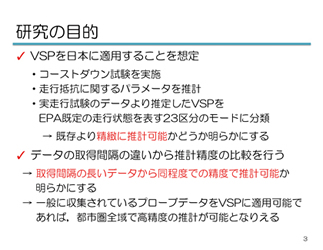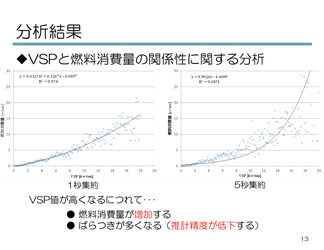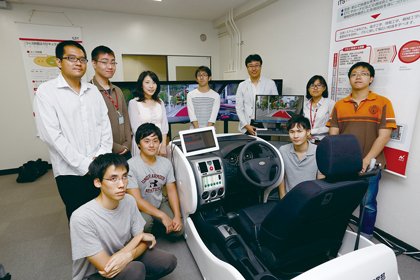Academy User Vol. 6
Nihon University
Fukuda & Ishizaka Lab, Traffic System Research, Department of Traffic System Engineering, School of Engineering
Using advanced ICT solutions to research and evaluate drivng behaviours for environmentally-friendly driving.
Porcurement of driving simulator to monitor and evaluate drivers' reactions, and coordination with micro traffic simulations.
Academy Information
Department of Traffic System Engineering, School of Engineering, Nihon University
URL : http://www.trpt.cst.nihon-u.ac.jp/Location : Funabashi, Chiba Prefecture
Research Focus : Floating Car Data, Eco Driving, Vehicle Dynamics Analysis
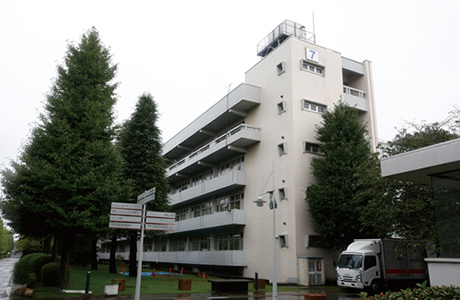
▲School of Engineering, Nihon University
"In
the recent 5 years we have put significant emphasis on researches using
ICT technologies to monitor and analyze fuel consumption and vehicle
dynamics," says to Associate Professor Tetsuhiro Ishizaka. During these
years, Professor Ishisaja has had the chance to go on an researcher
exchange program to the Center for Environmental Research &
Technology of University of California, Riverside. That experience has
deeply influenced in his recent research approahes.
Nihon
University Funabashi Campus is located right in front of the
Funabashi-Nichidaimae Station along the Tokyo Metro Tosai Line, with
its front gate wide-open facing the station, welcoming visitors.
Proceeding southwards and passing through the campus full of greens,
one would finally arrive at the "Traffic Systems Research Lab", where
Professor Ishizaka passionately works at. While he has always been
using real vehicles for his researches, as the variables and complexity
of his researches increase, he had his eyes on the UC-win/Road Driving
Simulators last year. Currently, he is using the drving simulator to
log and evaluate driver reactions, and feeding back the data obtained
onto micro traffic simulations.
Enhancing Traffic Planning & Engineering, and ITS Technologies Research through ICT
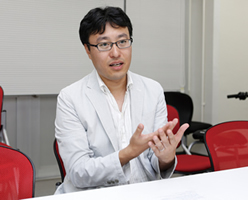
▲Associate Professor Tetsuhiro Ishizaka, Traffic System Engineering
"Our 'traffic system engineering' department specializes in traffic planning and engineering. Having a dedicated department to this field in civil engineering is quite uncommon, especially in Japan," commented Professor Ishikawa.
Nihon University is a prestigious private university that is famous for setting some "record highs" in Japan, such as total number of (graduated) students, largest total campus area (relative to other private schools), and most number of students passing the Japan 1st Class Architect Exam. The university was founded in 1889 and its Engineering Department had its roots trace back to 1920 when it was established as part of Nihon University Senior High, which would then become the current School of Engineering following 2 name and administrative changes into its current status.
In 1961, the automobile revolution became obvious in Japan, which became the reason for the founding of the Department of Traffic Systems Engineering under the School of Engineering. Later on, the department continues to expand into the research of construction or operation of other traffic systems, such as railway, air traffic, and sea freights. In 1979, the Traffic Civil Engineering Research group was established, which would become the current Department of Traffic System Engineering by 2013 due to the developing trend of coordinating with numerous ICT technologies such as the "SMART features", and internal demands for globalization.
The "Traffic System Research (Fukuda, Ishizaka Lab)" Associate Professor Ishikawa belongs to was established in 1992, by Professor Atsushi Fukuda to conduct researches on traffic system analysis through a system engineering perspective. Since then, the research group has been utilizing numerous ICT approaches, such as micro traffic simulation, floating data systems, or Bluetooth into their research approaches when evaluating traffic projects. The attention in ITS (Intelligent Traffic System) technologies recently has also been incorporated into a part of the lab's research directions.
Under
this backgroumd, Professor Fukuda has long kept his eyes on the
potentials of FORUM8's 3D real-time VR simulation software UC-win/Road.
The product has since become an excellent presentation tool and a
traffic simulation platform.
More Precision Research Approaches Inspired by International Experiences
"I am in the middle of taking what I have learnt from the US on monitoring techniques and adapting them to Japanese standards to refine our research approaches", said Professor Ishizaka - who was sent onto a researcher exchange program to the Center for Environmental Research and Technology of University of California, Riverside during 2011-2012. He reorganized the latest trends in the fuel economy regulations in the United States and proposed using off-cycle technologies to improve fuel efficiency and reduce CO2 emissions, an on-going topic he is still working on.
Professor Ishizaka has always specialized in traffic planning projects, but recently he is focusing on the monitoring of the fuel consumption of vehicles and their dynamics analysis, and hence the reason for adopting ICT technologies. For this reason, environment and ICT researhers has been increasing in the facility, researching side-by-side with the existing Traffic Planning group. Professor Ishizaka is confident and enthusiastic about vehicle and environmental monitoring through advanced ICT technologies to create some impactful results in the future.
One of the monitoring approaches he is highly interested in is VSP (vehicle specific power), the algorithms and related apps that model a vehicle's energy when moving. VSP is one of the techniques he has tried out in the US, hence his eagerness to use it in his own research projects after returning to Japan.
"Using VSP algorithms would require the parameters of the rolling friction force of the actual vehicle in motion", he explained. "This is usually obtained by putting a car in neutral gear, and letting it roll on its on from a speed of 100 km/h until you reach around 20 km/h. Then you monitor the distanced needed for that to happen in order to calculate further parameters such as tire, axle, mechanical friction, and air resistance. Once this is done you can proceed to make the VSP model."
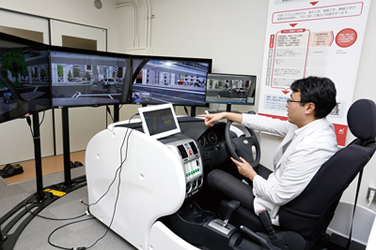
▲Monitoring vehicle fuel consumption and analyzing car behaviours through driving simulators. |
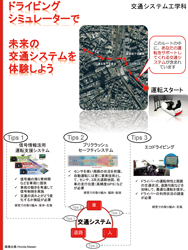
▲Demo run during open campus |
Background for Procuring a Driving Simulator
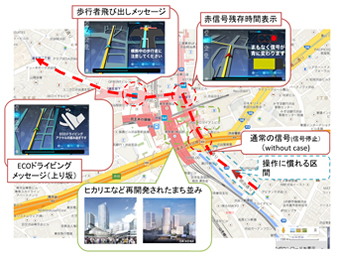 |
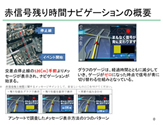
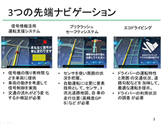
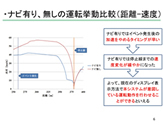
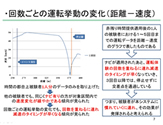 |
The
background for the procurement of UC-win/Road Driving Simulator was
related to the Department's direction in using ICT more profressively,
according to the Associate Professor.
On the other hand, it
was also because of the approaches and research questions he inspired
by his stay int the United States: 1. the feasibility of using satnav
displays to alter driving behaviours for eco-driving, and 2) using
high-precision GPS devices to record the speed, position, or gas &
braking controls of a driver to compare it with autonomous driving
trajectories in the future. The latter is of especial importance
because a driverless car likely will have a different driving style
from the user, as well as judgement criteria over the possibilities of
accidents; such discrepancies may become a source of stress or
frustration on the driver in the future.
Before
adopting a driving simulator, much of the monitoring work is done
through real cars, by fitting numerous sensors to directly obtain the
data necessary and to also develop the VSP models to derive the fuel
consumption. They also perform evaluation of traffic signal controls
and road alignment improvements through micro traffic simulations.
However,
performing micro traffic simulations merely allowed the researchers to
find ways to improve them. They needed a way to examine and verify if
the proposal really worked, and how drivers react to the new
changes.
”Nowdays we are being fed with numerous information onboard, and we also have autonomous driving on the horizon. It is now really a good time to examine how drivers' react to these information loads."
Under this backgroud, they started considering the need to adopt a driving simulator, and FORUM8 was ultimately selected. They also bought additional plugins to import and coordinate micro traffic simulation data into the simulator. Currently, they would load the numerous VSP models into the simulator and have a selection of sample drivers to to drive under a variety of situations. The data collected from the test subjects are than fed into mirco traffic simulation software in order to update the data.
The driving simulator is mainly run under the virtual environment of Shibuya area in Tokyo. In addition, they have set scenarios to simulate an ITS driving environment, such as the traffic lights in front of the driver sending data to advise drivers about the time until red lights, so the driver are better prepared on his/her speed controls to reduce unnecessary fuel consumption. Another example is the detection of pedestrian movement via these sensors and streamed to the drivers to avoid accidents.
These research approaches through the driving simulator has been made public through numerous open campus sessions. Visitors who toured the lab were able to have a demo run on their own to understand more deeply about what type of researches are being conducted here.
How Simulators Hold the Key to Linking with Micro Traffic Simulation and Future Outlook
"I have incorporated my own VSP model into the simulator based on Japanese traffic conditions, and have been investigating on fuel consumption during driving."
Professor Ishizaka is currently in the process of doing additional data logging of real vehicles to create the models that can be loaded into the driving simulator. The goal is to obtain the different reactions of the test drivers to determine what sort of information most effectively communicates to the test drivers in decreasing fuel conspumtion and greenhouse gas emission. The model he has created is extremely precise and is able to detect even the faintest traces of sudden gas inputs from the drivers.
However, he has expressed slight concerns over the vehicle behaviours, which is largely influenced by the type of simulator hardware that is being used. Thus, although the models for eco-driving have been precisely developed, it remains to be seen how it can take into account of multiple vehicles effecting the traffic condition.
"Once we are done with the fuel economy models, we really would like to enlarge our scale into the size of an entire city," Ishizaka commented. In other words, the situation of how individual vehicles may react when there is an information load coming from a much bigger area. He wishes to also incorporate his observations into micro traffic simulations to find out about the effects over an entire region.
For example, currently experiments are done in the fashion of how one individual car reacts to the remaining time of a green light. But what if this information is also transmitted to multiple vehicles, and how will they act altogether? This is where micro traffic simulation comes in handy, and he really wishes to start investigating as soon as possible.
"We have high hopes in the future development of UC-win/Road over more complicated and smoother coordination between the simulator and micro traffic simulation software, so that we can bring the scale of a project to a much bigger scale. Instead of evaluating individual vehicles, we eventually get to examine whole traffic flow, and maybe even better, the entire city, to go deeper and more complicated with our researches."
